Original article by: Stacy Muur
Compiled by | Odaily Planet Daily ( @OdailyChina )
Translator | Ethan ( @ethanzhang_web3 )
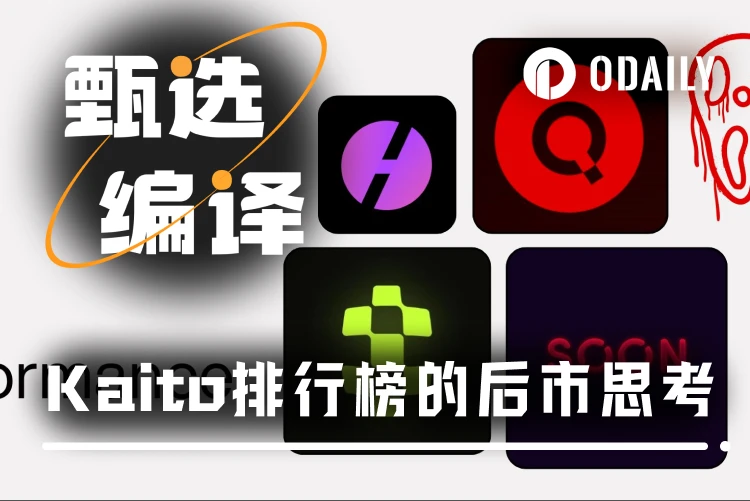
Memories in the new attention economy are short.
The crypto space has always been driven by narrative. But in 2025, a new mechanism for generating attention took center stage: @KaitoAI ’s Earn Leaderboards. These incentivized campaigns reward early researchers, commentators, and meme creators (colloquially known as “yappers”) who generate hype before a project launches in exchange for future token allocations.
Today, this gameplay has become standard procedure:
Reward early mindshare
Make up a story
Creating demand before TGE
It works. The charts bring exposure, transactions, and social proof. But the key question is: can this attention last?
Once the tokens are released and the airdrops are claimed, the same “yappers” have already moved on to the next pre-token hotspot. Prices slide, trading volume dries up, and participation fades.
This article critically examines several Kaito-related projects: SKATE, HUMA, QUAI, and SOON, to explore: Can the heat created by the Kaito model be sustained after the token is listed? The trend is obvious: the narrative is designed to detonate, not retain.
We start with SKATE.
Skate: High Volume, Listing on a Major Exchange, and Stagnation after the Kaito Boom
@skate_chain s native token, SKATE, a token for a modular gaming layer built on Solana, launches with strong momentum. With major exchange listings including Binance and Bitget, and a deeply embedded Kaito Earn campaign, SKATE enters the market with ample liquidity and exposure.
TGE: June 10, 2025
Issue price (opening price): 0.06506 USD
Closing price on the first day: $0.05094
First-day trading volume: $41.46 million
Initial FDV (fully diluted valuation): approximately $65 million
Current price (July 7): $0.04065
Current FDV: Approximately $40.65 million
Drawdown since TGE opening: ~37.5%
Current 24-hour volume (July 7): $8.46 million
Volume/Market Cap Ratio (July 7): ~139%
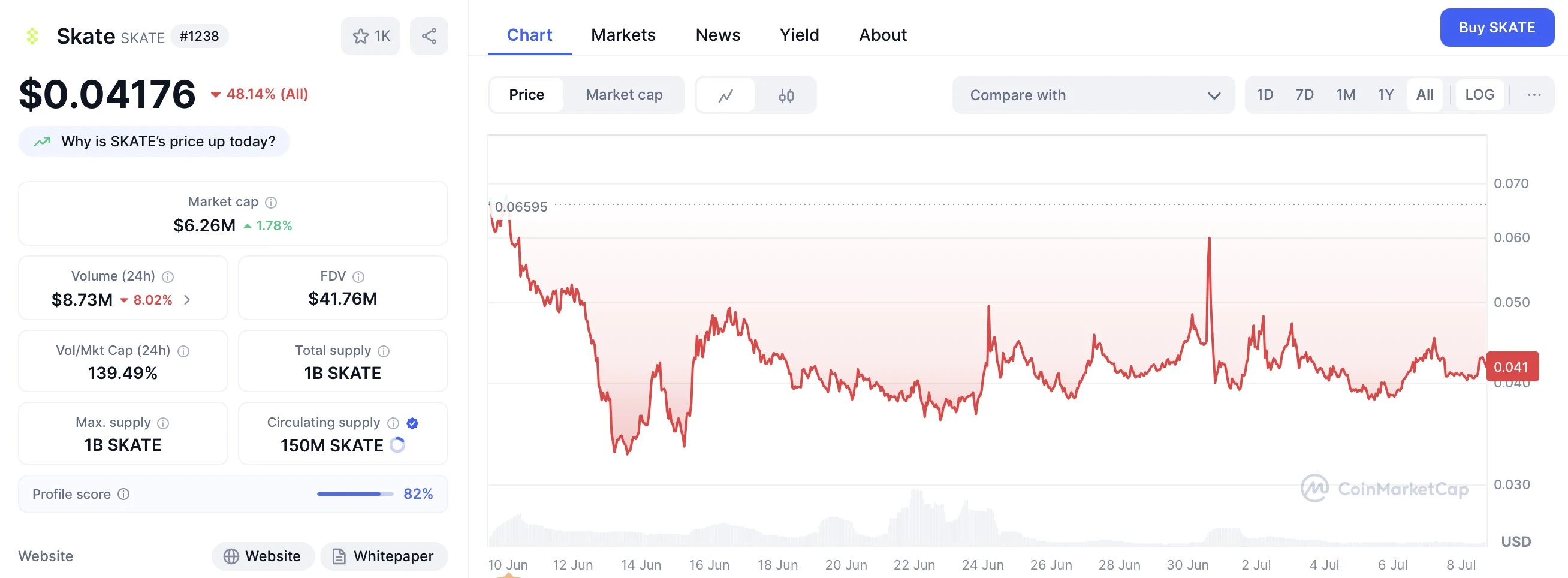
Price action: From surge to decline
Early trading in SKATE reflected a promising start. On June 10, the token saw a sharp rise in interest, peaking at 0.06539, but quickly pulled back to close around 0.05094, retracing about 22% on the first day alone.
What follows is a familiar trajectory seen in other Kaito-related projects:
Mid-June: Rebound to $0.051–0.048 range on the back of post-listing momentum (June 11–16)
June 21-23: Huge volume rotation (over $110M+ in a single day) but no strong sustained direction
June 30-July 4: Temporary volatility, price spikes to $0.06234 before quickly falling
July 5-7: Price was compressed to $0.04065, confirming a ~37% retracement since the TGE and ~22% decline from its July 4 swing high.
Social popularity also peaked early on and then quickly deteriorated. Within 7 to 10 days of the project launch, Kaito contributors turned their focus to new leaderboard projects and pre-coin launch events, resulting in a significant drop in mentions and engagement.
Summary: Rotation > Retention
SKATE had all the right ingredients: a major CEX listing, high liquidity, and a rewards-driven Kaito ecosystem narrative. But the attention didn’t last. Despite daily trading volume of nearly 140% relative to market cap, SKATE remains an asset that is highly rotated rather than held.
Its story mirrors other tokens in the Kaito Earn space:
Pre-release hype
Immediate listing-driven trading volume
Airdrop collection and quick withdrawal
Narrative exhaustion within weeks
SKATE’s market behavior reinforces the growing criticism of Kaito’s push for project issuance: high exposure, low stickiness.
Huma: Launchpool fever, 0.5% Kaito rewards, and $300 million in first-day rotation
@humafinance , a decentralized PayFi, launched its native token HUMA on May 26, 2025, with the top support from Binance and Kaito.
The Binance Launchpool campaign let users mine HUMA by staking BNB, FDUSD, or USDC between May 23 and 26. Meanwhile, Huma ran a Kaito Earn campaign that allocated 0.5% of the total supply across three reward “seasons.”
Season 1 Distribution:
0.1% is allocated to the top 500 Kaito yappers (30-day, 3-month, 12-month awareness share);
0.1% is allocated to contributors in the Solana, DeFi, and RWA categories;
Allocation is qualified through SOL wallet registration and holding of Kaito Ecosystem Tokens.
Trading began on Binance at 13:00 UTC on May 26. As of May 27:
TGE (opening) price: 0.06683 USD
Closing price on the first day: $0.05936
Drawdown from opening: about 11.2%
First-day trading volume: $310.37 million
Market value on the first day: $102.89 million
Current price (July 7): $0.03083
Current market value: $53.44 million
FDV (fully diluted valuation): $308.6 million
Volume/Market Cap Ratio (July 7): ~33%
Despite the excitement generated by Launchpool and Kaito Earn, HUMA’s trading activity is still dominated by short-term rotation. Season 1 rewards were available from day 1, and Season 2 has been announced, which encourages selling rather than long-term holding.
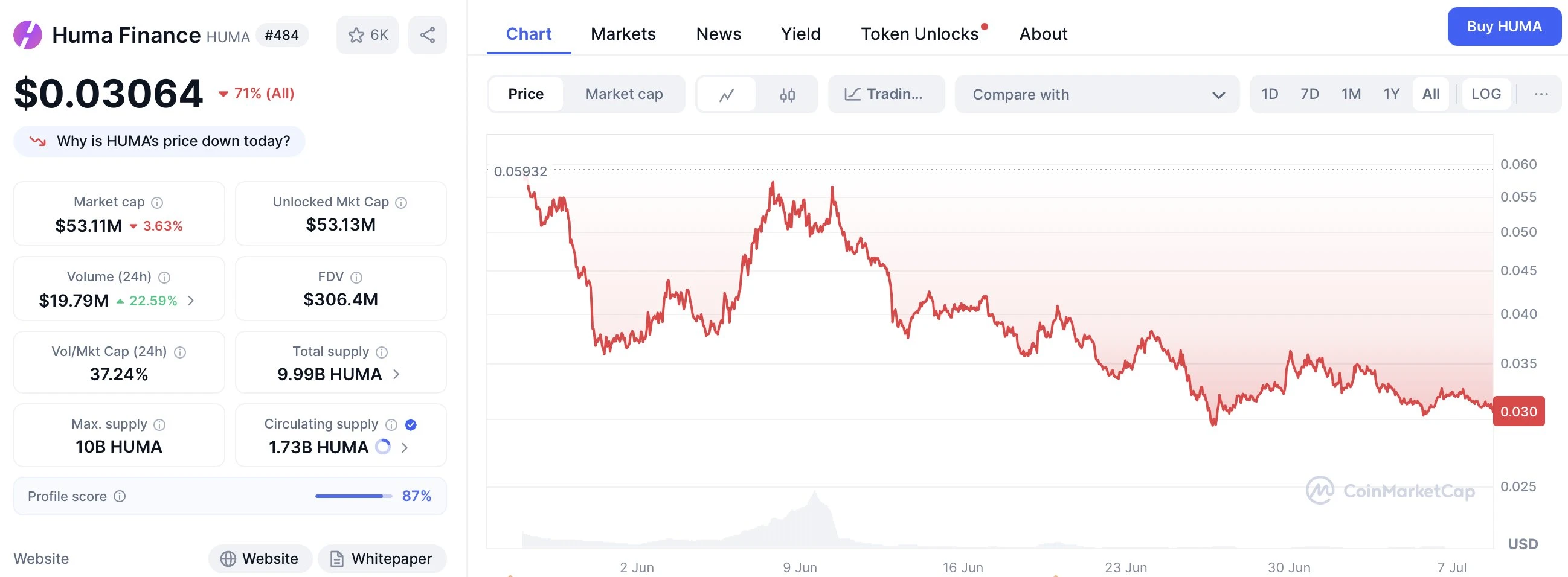
After briefly stabilizing at ~$0.05 in early June, the price steadily declined over the next month, falling 40% from June 9 to July 7. This trend reflects not only profit-taking, but also a broader phenomenon of lack of sticky demand. Daily volume is down over 90% from the Day 1 high, and the widening gap between FDV ($308M) and realized market cap ($53.44M) reinforces the perception that much of HUMA’s traction is driven by activity, not product.
summary
HUMA exhibits the typical Kaito Earn pattern: lots of hype, plenty of liquidity, but lack of lasting traction. The launch was designed for exposure, not necessarily for conviction. Without post-launch utility or demand hooks, early attention rotates out as fast as it rotates in.
Quai: Large allocation, deep Kaito integration, strong start… then quiet
@QuaiNetwork , a decentralized, multi-threaded blockchain protocol, has launched one of the most generous and deeply integrated Kaito Earn campaigns to date. From January 17 to April 17, 2025, the project has distributed a total of 6 million QUAI tokens as rewards to content contributors:
5.5 million QUAI for the general Kaito leaderboard;
500,000 QUAI are used for a dedicated Quai project leaderboard.
The claiming period is open through the Kipper platform from April 29 to May 12. Weekly snapshots track contributors, and top yappers like @0xalank , @basedPavel , and @Abhijeetcg have received up to 5.95% of individual awareness share, much higher than SKATE or HUMA.
While the Quai mainnet launched on January 29, the token was not freely tradable until February 22, when exchange data became available.
QUAI first day performance (February 22, 2025):
Opening price: 0.09884 USD;
Highest price: $0.2263;
Closing price: $0.1929;
Volume: $10.14 million.
What happened next: Rotation, reversal, and a long cool-down
QUAI had one of the most explosive debuts of any Kaito-related token. It surged 129% from $0.09884 to $0.2263 during the day, closing at $0.1929.
But that was the peak.
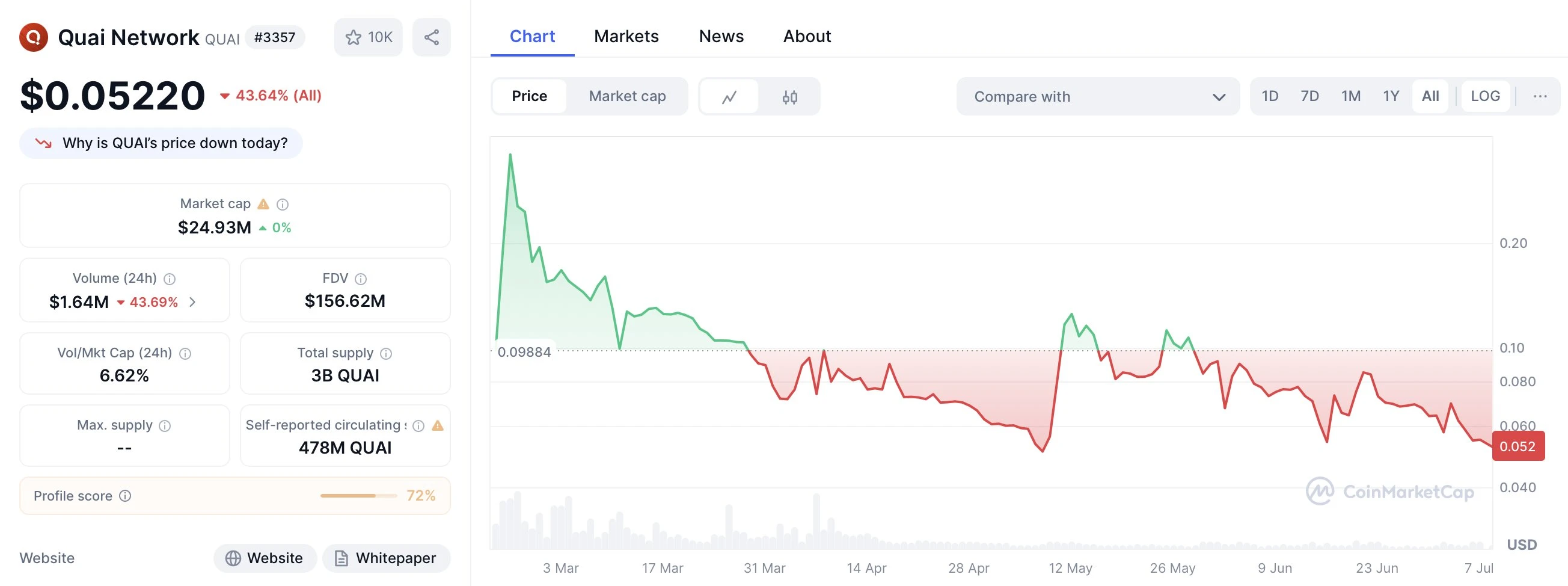
In the coming weeks:
February 23-26: Prices fell to the $0.17 to $0.18 range, cooling off quickly early on.
March 1-15: A steady decline to the $0.12 to $0.08 range, showing a pullback consistent with the subsequent heat decay.
April-May: Despite some minor rebound attempts, support gradually weakened.
June to July: The token entered the $0.06 to $0.07 range and as of July 7, it was trading at $0.05266, down about 73% from the closing price and about 76.7% from the highest price.
The trading volume also speaks for itself:
From 10 million on day 1 to about 3 million currently, there has been a dramatic drop in activity.
Even the Phase 2 Kaito rewards failed to materially boost demand post-TGE.
summary
QUAI has it all: huge Kaito allocation, strong brand synergies, hyped TGE, and early price action that signals momentum. But attention moves fast. Even top yappers with >5% individual awareness share can’t sustain secondary market interest.
QUAI is now trading below its offering price and has not seen any meaningful recovery since March, a classic case study in “ early liquidity ≠ lasting conviction.”
Soon: Kaito Synergy, Binance Alpha Buzz, and a Harsh Reality Check
@soon_svm , a high-performance Solana Optimistic Network (SVM-based rollup), ran one of the most structured and community-syndicated Kaito Earn campaigns in early 2025. The project distributed 450,000 SOON tokens (~0.045% of total supply) to the top 100 yappers over a 3-month campaign window.
Event dates: February 19 to May 19, 2025;
Collection period: May 23 to June 23, 2025;
Eligibility: Kaito leaderboard contributors, early NFT holders, builder badge owners;
Reward Type: Token-based airdrops via airdrop.soo.network.
The event was more than just a prize distribution; it was embedded in SOON’s identity. Participants were awarded “Sooner” roles, badges, and social status, reinforcing the grassroots narrative that Kaito yappers were at the heart of SOON’s early evangelism.
TGE and market launch: from boom to decline
SOON’s token was issued on May 23, and Binance Alpha listing began trading on May 24. The token opened at $0.4527, briefly touched $0.4776, and closed the day at $0.4007. The trading volume on the first day soared to $103.1 million, showing strong speculative activity and the amplification effect of the exchange.
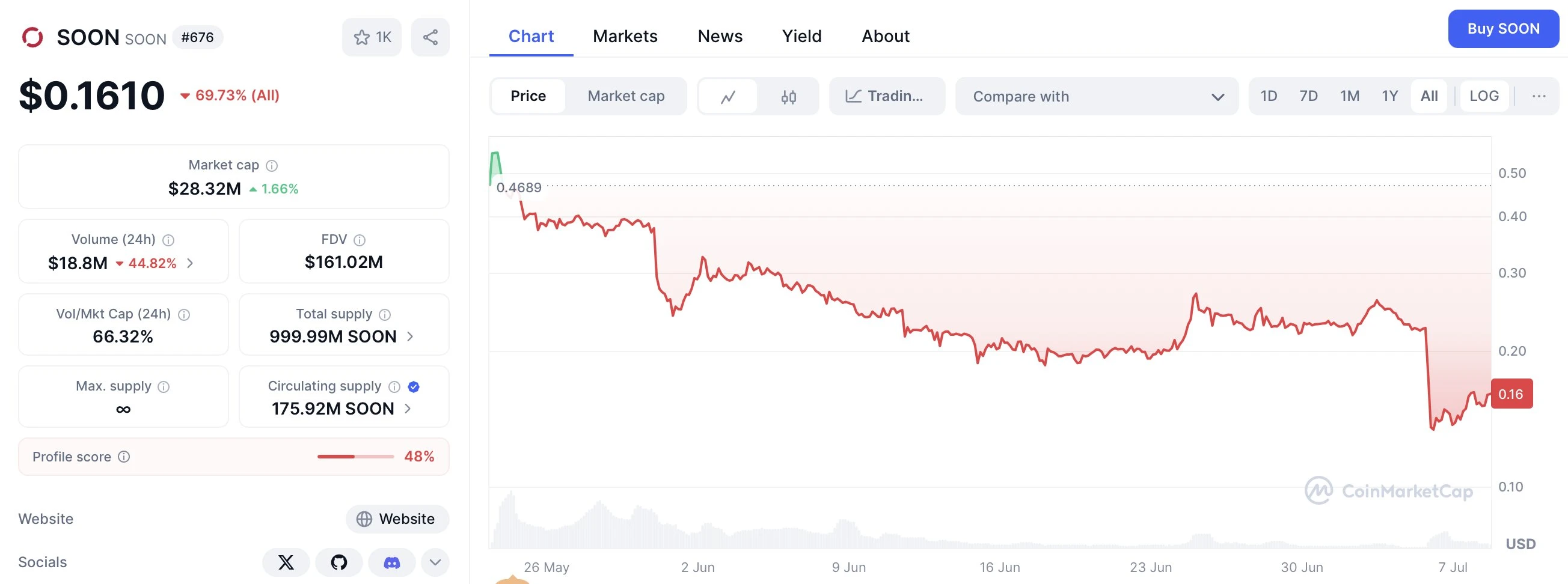
Market Indicators (as of July 7, 2025):
TGE Date: May 23;
Opening price on the first day: 0.4527 USD;
Closing price on the first day: $0.4007;
First-day volume: $103.1 million
Current price: $0.1529;
Market value: approximately $26.9 million;
Drawdown since opening: about 66.2%;
Retracement from the highest point: about 68.0%;
Volume/market cap ratio (July 7): ~97%.
What happened after the first day?
After the initial excitement, SOON followed the now-familiar post-Kaitos trajectory:
Late May to mid-June: SOON remained in the $0.29 to $0.39 range with moderate turnover and slow decay.
Late June: Support fell below $0.25, with the decline accelerating on June 27-30.
July 5-7: SOON plummeted 40% in 48 hours, from $0.22 to $0.13, before rebounding slightly to $0.15.
This sharp drop coincided with the end of the claim period (June 23), and many claimants likely sold afterward, with attention shifting to other Kaito activities.
Summary: The sooner you sell?
SOON had all the ingredients for a successful launch: strong infrastructure hype, exposure on Binance Alpha, and community-coded incentives. But the token’s 66% retracement in six weeks shows that hype has not translated into conviction.
Kaito Earn patterns have become predictable:
Narrative driven airdrop → High first day volume → Rapid airdrop rotation → Price drops as attention shifts
Despite SOON’s efforts to integrate into the community culture, its market behavior is a case study in the fragility of attention. Its Kaito roots gave it a loud start, but couldn’t prevent the silence that followed.
Conclusion: Narratives are cheap, beliefs are scarce
The Kaito Earn model has proven to be a powerful engine for pre-launch exposure, but across SKATE, HUMA, QUAI, and SOON, a consistent pattern emerges:
Attention peaks at TGE but fails to translate into long-term conviction.
Despite differences in domain (gaming, infrastructure, PayFi), listing platform (Binance, Bitget), and reward structure, the results are strikingly similar:
The token gained on the first day;
Airdrop recipients rotate out;
Price action flattened out over the weeks.
This isn’t a failure of Kaito per se, as it performs well as a content discovery layer, but the current model incentivizes narrative creation rather than long-term belief. Without real utility, retention mechanisms, or sustained product demand, most tokens issued through this channel will get stuck in an attention or exit cycle.
Unless this cycle can be broken with token design that no longer just hypes but rewards holding, Kaito’s model may remain just that: a powerful launch platform with few successful landings.










